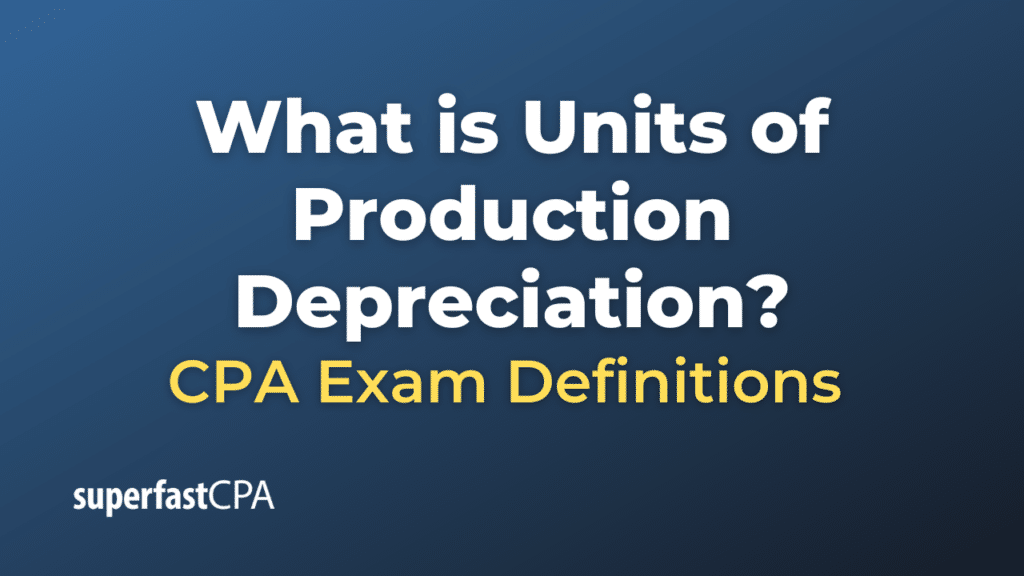Units of Production Depreciation
Units of Production Depreciation is a method of calculating depreciation for an asset based on its actual usage rather than the passage of time. Unlike the straight-line or declining balance methods, which spread the depreciation expense uniformly over the asset’s useful life, the Units of Production method allocates the expense based on the asset’s actual level of production or use.
Formula
The formula for calculating the depreciation rate per unit is:
Depreciation Rate per Unit = Cost of Asset − Salvage Value / Total Expected Units of Production
Once the depreciation rate per unit is calculated, you can find the depreciation expense for a given period using:
Depreciation Expense for the Period = Depreciation Rate per Unit × Units Produced in the Period
Benefits and Limitations
Benefits
- Accuracy : The Units of Production method is often more accurate in matching depreciation expense with the actual wear and tear on the asset, as it’s based on usage.
- Cost Matching: It aligns well with the cost principle by matching the cost of the asset with the revenue it generates.
Limitations
- Complexity: It requires accurate tracking of the actual units produced, which can be complex and time-consuming.
- Inapplicability : It may not be suitable for assets where wear and tear are not directly related to production volume.
The Units of Production Depreciation method is particularly useful for assets where the level of activity significantly affects the wear and tear or the value depreciation over time, such as manufacturing machinery, vehicles based on mileage, or copiers based on the number of copies made.
Example of Units of Production Depreciation
Let’s go through a detailed example to illustrate how Units of Production Depreciation works.
Scenario
Imagine a company purchases a specialized manufacturing machine for $200,000. The machine has an estimated salvage value of $20,000 at the end of its useful life. The total expected production capacity of the machine over its useful life is 500,000 units.
Step 1: Calculate Depreciation Rate per Unit
First, we calculate the depreciation rate per unit using the formula:
Depreciation Rate per Unit = Cost of Asset − Salvage Value / Total Expected Units of Production
Depreciation Rate per Unit = $200,000 – $20,000 / 500,000
Depreciation Rate per Unit =$180,000 / 500,000 = $0.36 per unit}
Step 2: Calculate Depreciation Expense for Each Year
Assume the machine produces the following number of units over three years:
- Year 1: 40,000 units
- Year 2: 50,000 units
- Year 3: 45,000 units
For each year, we use the formula to find the depreciation expense:
- Year 1 Depreciation Expense:
Depreciation Expense = $0.36 x 40,000 = $14,400 - Year 2 Depreciation Expense:
Depreciation Expense = $0.36 x 50,000 = $18,000 - Year 3 Depreciation Expense:
Depreciation Expense = $0.36 x 45,000 = $16,200
Step 3: Accounting Entries
For each year, the company would make the following accounting entries to record the depreciation:
- Year 1: Debit Depreciation Expense $14,400 and Credit Accumulated Depreciation $14,400
- Year 2: Debit Depreciation Expense $18,000 and Credit Accumulated Depreciation $18,000
- Year 3: Debit Depreciation Expense $16,200 and Credit Accumulated Depreciation $16,200
Summary
The Units of Production Depreciation method allows the company to match the depreciation expense more closely with the actual usage of the asset. In years when the machine produces more units, the depreciation expense is higher, reflecting the greater wear and tear on the machine.
This method is especially useful for assets like manufacturing machines, where the wear and tear are directly related to the level of production activity.













